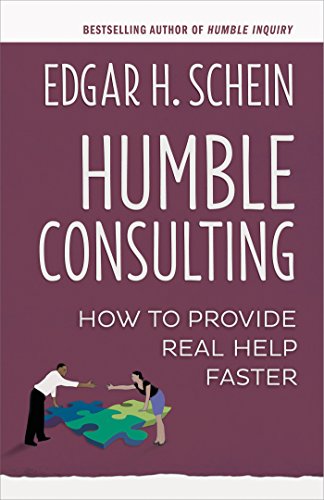Humble Consulting
Schein, Edgar. (2016). Humble Consulting. San Francisco: Berrett-Koehler.
Process Consultation emphasizes the need to involve the client in the process of figuring out what is wrong and what can be done about it. This statement in the preface sets the tone. As a consultant, I spent a lot of time telling. To be sure, there are times to be overt and direct. As a starting point, however, using some of the skills and strategies outlined in Helping and Humble Inquiry might produce results without giving premature advice.
As Schein points out, many solutions are not technical ones. He quotes Heifetz as one who says complex problems today need more ‘adaptive solutions.’ The process of finding solutions is a more long-term strategy than the one problem/one solution that can become Whack-a-mole.
Being the expert and providing information and/or advice works, but only for simple, bounded problems. That process also failed if the problem was complex, culturally multifaceted, and constantly changing. Being the expert can set up the client to become dependent on your ideas and reduce their taking on responsibility of building problem solving systems.
Why Are Problems Messier These Days?
HC Requires a New Kind of Personal Relationship with the Client. In working on messier problems and trying to get at what is really on the client’s mind and what is worrying him
HC Requires a New Kind of Behavior in the Very First Contact. “Tell me a little bit more about what you have in mind.” “Why do you want to do this culture survey?” “What problem are you trying to solve?”
HC Requires a New Attitude of Humility, a Commitment to Helping, and Curiosity. Honor the difficulties that the client faces and to focus on him and the situation, not on my own needs to sell myself, my skills, and my insights. I allow myself to become genuinely curious. It is honest, spontaneous curiosity that best conveys my interest and concern for the client.
“HC attitude.” Think of it in terms of the three Cs—commitment, curiosity, and caring.
- COMMITMENT: YOU HAVE TO BE EMOTIONALLY READY TO WANT TO HELP. Try not to worry about whether this will produce income or not; let your motive be to see if you can solve the client’s problem.
- CURIOSITY: YOU HAVE TO WANT TO KNOW “WHO IS THIS PERSON?” AND “WHAT IS THE SITUATION?” Be genuinely curious, because that will make you an active, engaged listener from the moment you are in contact with the other person.
- CARING: YOU HAVE TO GET PERSONAL AS QUICKLY AS POSSIBLE. Focus on the person and what the client-to-be says to you. Clear your mind as much as possible of preconceptions.
Another tenet in Stakeholder Centered Coaching is the discipline to follow through. In a good working relationship, I need to be able to predict how much I can count on you to make and keep your commitments and how open and reliable you will be in your communication with me.
At one level of consulting can become pseudohelp. We meet, we talk, we have great discussions. Yes, I have done this. I let myself become seduced by the problem or the organization. This produces little, if any, real or lasting change.
At the next level of consulting. Schein asks the question, “Is what we are doing really helping?” At this level we want to investigate the data, the culture, and the goal of our consulting. Another question that can be revealing is, “Why did you decide to call me?”
Schein cited an example whereby people at a meeting get frustrated by the agenda. The participants say they never got to the real issues. After two hours (or how ever long the meeting is scheduled) people walked away without real discussion of issues and possible solutions. Schein asked a question, “where did this agenda come from?” Answer, the executive’s secretary.
They asked the secretary to join the meeting. Schein asked how she developed the agenda. She said she put down the items as the participants would call her. It was timing. There was no effort to prioritize the items prior to the meeting or at the beginning of the meeting. If this is a problem, why not prioritize what has to be decided during the time we meet. How many procedures endure because no one ask a question or challenges the process?
In this book Schein addressed several scenarios that are pertinent to many of our organizations. The only principle is that you should remain committed to being helpful. The most dangerous aspect of being the helper is to give premature advice and thereby to undermine your own credibility. The trap for the helper is that the client had considered it, ruled it out for various good reasons, and now wonders why the consultant has come up with such a bad idea.
In the end, the goal is to find out what the client is worried about, what they see as the preferred future, and what are the immediate and long-term problems to be addressed.

